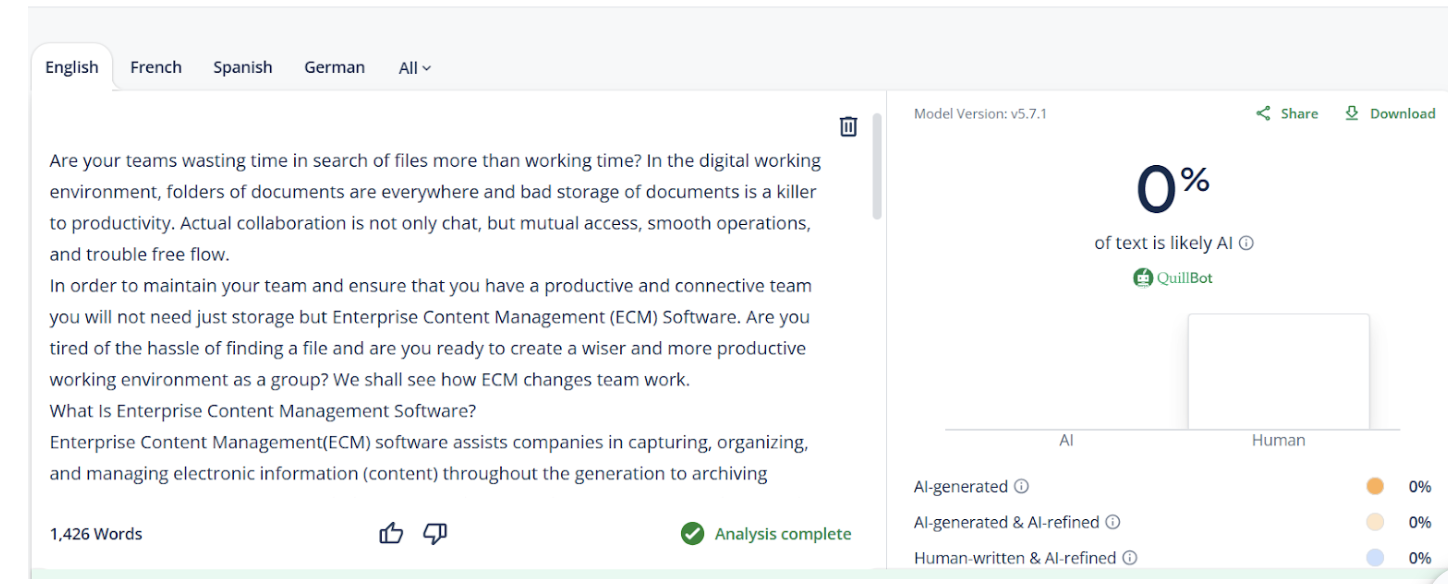Are your teams wasting time in search of files more than working time? In the digital working environment, folders of documents are everywhere and bad storage of documents is a killer to productivity. Actual collaboration is not only chat, but mutual access, smooth operations, and trouble free flow.
In order to maintain your team and ensure that you have a productive and connective team you will not need just storage but Enterprise Content Management (ECM) Software. Are you tired of the hassle of finding a file and are you ready to create a wiser and more productive working environment as a group? We shall see how ECM changes team work.
What Is Enterprise Content Management Software?
Enterprise Content Management (ECM) software assists companies in capturing, organizing, and managing electronic information (content) throughout the generation to archiving process. It saves on paperwork, eliminates confusion of version, and all the data is stored in a secure location. ECM can guarantee accessibility, recentness and safety of documents, allowing easier cooperation and wiser decision making.
Key Components of an ECM System
- Storing files in one central place and making them accessible.
- Eliminates paperwork and increases approvals.
- Allows teams to access and share documents in a safe location.
- Maintains that documents are well prepared, updated and archived appropriately.
- Integrates well with office 365, CRM or ERP systems.
Why Team Collaboration Matters in Modern Workplaces
Contemporary labour requires flexibility. Due to the popular transition to remote and hybrid models, team collaboration is not optional anymore, but a necessity. It is fueled by digital workplace tools that have made communication between employees real-time and made project execution to be smooth without location issues.
Common Challenges Without ECM
When teams lack the proper system, they experience daily frustrations that destroy productivity:
- Scattered Files: Important documents have been scattered in the drives and inboxes, and it is almost impossible to locate them.
- Version Chaos: Teams operate on old versions (Final_v3), and make errors and wastes of time.
- Delayed Processes: Manual approvals cause bottlenecks thus halting the projects.
- Absence of Visibility: The ownership or accountability cannot be easily followed, which leads to delays.
How Enterprise Content Management Software Improves Team Collaboration
1. Centralized Content Access
Enterprise Content Management Software is a single and centralized point of all your documents. Centralization of access enables teams to access what they require easily without searching numerous drives and folders to locate them hence collaboration among teams is fast and efficient.
2. Real-Time Editing & Co-Authoring
The effective document management system allows a number of people in the team to operate under files simultaneously. The feature of real-time editing is useful to remove version conflicts and keep all people within the digital working environment on the same page, raising productivity.
3. Automated Workflows
The automation of the workflow simplifies the routine duties such as approvals, reviews, and notifications. Automating these processes allows teams to work on something important and ensures the flow of the projects.
4. Secure Document Sharing
EMC software enables enterprise file sharing, which keeps sensitive documents safely shared across the team. Secure access controls ensure the privacy of your data at the same time so that the right individuals can work together wherever they choose.
5. Integration with Collaboration Tools
Enterprise Content Management Software integrates with your current digital working tools, including email, CRM, or project management tools. This integration is used to make sure that there is harmony of teamwork across several systems.
6. Enhanced Transparency & Reporting
The ECM content lifecycle management will give visibility of who, and when, a document was accessed or edited. Open reporting holds everyone responsible and thus tracking of progress is more easily done and team performance is also optimized.
Best Practices to Boost Collaboration Using ECM Tools
- Train and Educate Teams
The only way that your ECM system is effective is through the people who use it. Conduct extensive training programs to familiarize the workers with the features, worker processes, and advantages. Provide practical experience and develop quick reference guides. Trained teams will embrace tools more quickly, produce less mistakes and will work more as a team.
- Establish Clear Access Policies
Identify who is able to see, update and share documents. Clearly defined access policies ensure less confusion, unauthorized modifications, and data integrity. Permission can be assigned to individuals based on their position, which ensures that not only sensitive information is safeguarded but that the work is done easily, with everyone understanding what they can create and where.
Encourage Consistent Document Management
Consistency is key. Established rules of file naming, folders and document tags. Having all the people under the same structure saves time as all of them do not have to find information and spend more time working on the projects.Clear understanding leads to faster decision-making and eventually streamlining of work processes.
- Review and Update Regularly
The ECM system does not maintain it and forget it. Arrange periodic audits in order to delete ancient information, restructuring files, and streamlining functions. The maintenance of the system clean and up-to-date maintains the collaboration as efficient and as pertinent to the business needs as it is.
Use Cases: How Businesses Benefit from ECM Collaboration

What the data says: ECM teams have reported improvements as much as 40 percent faster approvals and 25 percent lower version errors than with traditional approaches.
Choosing the Right Enterprise Content Management Software
Key Factors to Consider
- The system must be user friendly to everyone and should be able to expand with your business.
- It should be capable of integration with already existing tools, for example, CRM, ERP, or office 365.
- Requires robust data security and adherence to such regulations as GDPR or HIPAA.
- Approvals, notifications and document routing automation improve productivity and collaboration.
Popular ECM Solutions
- Microsoft SharePoint – Flexible, used by many, and suitable in large companies.
- OpenText Content Suite – Powerful document management and regulatory compliance.
- M-Files –Targets metadata-based organization to search and retrieve smarter.
- DocuWare – Easy to use and highly automated workflow.
- Laserfiche – Perfect in high-security document management and business enterprise processes.
How Techimply Can Help
Techimply simplifies the process of comparing, examining and choosing the most suitable ECM software to use in your business. Techimply takes you to a solution, whether you are a small firm or a big company, solutions that are of your size, needs and workflow.
Conclusion
Teamwork is the engine of any successful company--and it requires well-organized, easily available information. Enterprise Content Management Software gives you the opportunity to create a single source of truth that leads to decisions made quickly and workflows that flow smoothly. The right ECM tool simplifies operations, automates and improves cross-team work. Select one that will fit seamlessly to give order to the disorder. Find and compare the best Enterprise Content Management Software on Techimply.
____________________






.png)
.png)
.png)
.png)